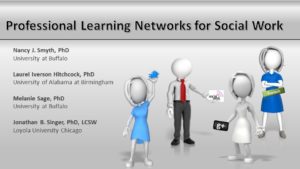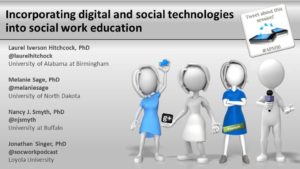BPD Technology Committee’s Technology Assessment Checklist for Social Work Practice
Editor’s Note: This blog post was written by myself and my colleague, Dr. Nathalie P. Jones. We have been the co-chairs of the BPD Technology Committee for the past two-years (2017-2019) and served as editors for the Technology Assessment Checklist described and shared in this post.
In response to the growing influence of technology in the lives of individuals and families, the Technology Committee for the Association of Baccalaureate Social Work Program Directors (BPD) has created the Technology Assessment Checklist for Social Work Practice. This tool is designed to help social workers assess clients’ relationships and comfort with technology, including strengths, needs, risks, and challenges. This blog post describes the process used by the BPD Technology Committee to create this list as well as providing a description.
History of the BPD Technology Assessment Checklist
At the 2016 Annual Conference in Dallas, TX, the BPD Technology Committee embarked on a project to help create an assessment tool for social work practitioners and educators related to digital and social technologies. The goal was for the committee members, and others who were interested in the project, to work collaboratively to develop questions that could be used with individuals and families for the purposes of assessing clients’ use and relationships with digital and social technology. After the meeting, a call was put out on the BPD Listserv and a group of ten social workers agreed to assist with creating a technology-based assessment.
#husITa18/#SWSD2018: Sustaining lifelong learning through the use of Technology-Mediated Professional Learning Networks
On Friday July 6, 2018 at 3:15 PM in the Exhibition Hall at the 2018 International Social Work, Education & Social Development Conference, Melanie Sage, Nancy J. Smyth, Jonathan Singer, and I are presenting a poster about how social workers can use technology for career-long learning, specifically by creating a Professional Learning Network (PLN).
Simply stated, PLNs employ, within an online environment, the same strategy that social work professionals have used for centuries: the practice of connecting to people who share interests and can learn from each other. PLNs are a well-established practice in the field of education (Richardson & Manacebelli, 2011). The term comes from the educational technology learning communities and has its origins in Connectivism, a learning theory developed by George Siemens (2005) to explain how network-based learning occurs in the digital age. Specifically, Connectivism suggests that learning is the process of connecting sources of information together across networks, shifting learning from an individual process to a community effort. Thus, learning includes the skills of managing the flow of information, determining what is and is not useful information, and maintaining connections with others to facilitate on-going learning (Siemens, 2005). All of these skills are developed and applied with a PLN.
We are all big fans of PLNs, and have been sharing the practice with the social work community in the US for over a year now. Nancy, Melanie and I introduced the idea of professional learning networks (PLN) to a packed room of social workers at Social Work Distance Education Conference in April 2017, and have highlighted the practice in our upcoming book with Council on Social Work Education (CSWE) Press – Teaching Social Work with Digital Technology. In October 2017, the three of us along with Jonathan shared tips and tricks for setting up a PLN at CSWE’s Annual Program Meeting. Finally, Melanie and I wrote an article for Social Work Today about PLNs was published in March.
All of us also have our own PLN that we actively employ and nurture for our own professional learning. In the following, we each describe our own PLN:
 Melanie’s PLN: My goal is to build professional relationships around my scholarships interests, and to model positive technology – use for my peers. My PLN includes:
Melanie’s PLN: My goal is to build professional relationships around my scholarships interests, and to model positive technology – use for my peers. My PLN includes:
– husITa and other technology groups: I am a board member of husITa and active with other tech groups. I follow all of them via different social media platforms and share links to technology related content.
– Facebook: I participate in several closed professional social work & technology groups on Facebook for professional reasons, but I mostly use FB to deepen my connections with colleagues and friends.
– Twitter: This is my go-to-app for initial networking as it is easy to find people, quickly learn about their interests, and engage with short posts (under 240 characters).
– Listservs: I belong to several email-based listservs where I can learn about trends and share my own research.
– CSWE Councils: I am a member of a CSWE Council and here is where I work to connect my in-person network with my digital network, by talking to others about how leaders can use social media to connect and share information.
Using Technology for Social Work Scholarship: Creating and Sharing your Work
This post was written and edited by Nancy J. Smyth, Melanie Sage, and myself as part of our collaboration on our forthcoming book, Teaching Social Work with Digital Technology, to be published by CSWE Press in 2018.
Social and digital technologies offer many tools and opportunities to create and disseminate scholarship in social work. For example, social work educators can use blogs, podcasts, videos, and infographics to create and share content for professional purposes. To see an example of how to use infographics, please see Harnessing Technology for Social Work Scholarship (Hitchcock & Sage, 2017). This blog post describes two social work academics are using social media to share their research with others.
Dr. Jimmy A. Young, an Assistant Professor of social work at California State University San Marcos, shares how he uses social media to disseminate his research:
Social media technologies offer exciting opportunities to disseminate scholarship with a broader audience and share your research with others. A few examples include using Twitter to share a quick highlight or quote with a direct link to the article, a blog post with a longer quote or summary and direct link to the article, or some sort of video message on YouTube or Snapchat that also shares a summary and direct link. Today’s social media users enjoy rich content and video is an engaging way to share articles with others. I have also been successful in using professional academic social networks such as ResearchGate or Academia.edu to host articles, post summaries and links, as well as to connect with others working in a similar area. The great thing about these websites is you can get some analytics that can be useful for demonstrating your scholarly impact. For example, I have open access articles on ResearchGate that have garnered thousands of views and many of these articles have found their way into other scholar’s work as citations. GoogleScholar is another great way to manage your academic profile online and keep track of your scholarship and citations. Remember that some publishers do not want their articles shared on these websites for copyright reasons, but more and more are beginning to allow academics to post pre-print copies and even full online print versions. ResearchGate has been very useful because they are establishing relationships with some publishers to ensure that your work is freely available to share with others. Also, remember that many publishers provide a number of free copies for authors to distribute, and these copies can be great to share on social networks and increase your citations, online presence, and maybe even make you famous. Perhaps just moderately famous. (J.A.Young, personal communication, November 3, 2017).
#APM17 – Harnessing Technology for one’s own Good: Professional Learning Networks in Social Work
 On 10/22/17, the last day of CSWE’s 2017 Annual Program Meeting, at 10:00 AM in the Dallas Ballroom A-2, Nancy J. Smyth, Melanie Sage, Jonathan Singer, and I are presenting about how social work educators can use technology for career-long learning. Nancy, Melanie and I introduced the idea of professional learning networks (PLN) to a packed room at Social Work Distance Education Conference in April, and wanted to bring the practice to the #APM17 crowd. A PLN incorporates technology-based tools and processes in a way that allows individuals to stay up-to-date and share information about current news, practice knowledge and current research findings. We will be talking about the mechanics, advantages and disadvantages of establishing a PLN. One resources we will be sharing is our Professional Learning Network (PLN) Worksheet, which takes a social worker through the steps of creating their own PLN. You can get your own copy here: https://drive.google.com/file/d/0ByR_E-iQH7PdT2t1WV9YYnlZV00/view?usp=sharing
On 10/22/17, the last day of CSWE’s 2017 Annual Program Meeting, at 10:00 AM in the Dallas Ballroom A-2, Nancy J. Smyth, Melanie Sage, Jonathan Singer, and I are presenting about how social work educators can use technology for career-long learning. Nancy, Melanie and I introduced the idea of professional learning networks (PLN) to a packed room at Social Work Distance Education Conference in April, and wanted to bring the practice to the #APM17 crowd. A PLN incorporates technology-based tools and processes in a way that allows individuals to stay up-to-date and share information about current news, practice knowledge and current research findings. We will be talking about the mechanics, advantages and disadvantages of establishing a PLN. One resources we will be sharing is our Professional Learning Network (PLN) Worksheet, which takes a social worker through the steps of creating their own PLN. You can get your own copy here: https://drive.google.com/file/d/0ByR_E-iQH7PdT2t1WV9YYnlZV00/view?usp=sharing
You can access a copy of the presentation slides here: https://www.slideshare.net/laurelhitchcock/professional-learning-networks-for-social-work-81048022
#APM16 Day 3 -Incorporating Digital & Social Technologies into Social Work Education
 This is Day 2 of CSWE’s 2016 Annual Program Meeting, and it will be a busy day. One of the highlights for me will be presenting as part of panel of other #swtech educators – Drs. Melanie Sage (University of North Dakota), Jonathan B. Singer (Loyola University & The Social Work Podcast) and Nancy J. Smyth (University at Buffalo, SUNY). Our panel discussion is about how to how to infuse social and digital technologies into social work courses and curricula. Topics will focus on digital literacy, using theory to inform the integration of technology into online courses, and creating assignments and learning activities for social work courses that incorporate technology.
This is Day 2 of CSWE’s 2016 Annual Program Meeting, and it will be a busy day. One of the highlights for me will be presenting as part of panel of other #swtech educators – Drs. Melanie Sage (University of North Dakota), Jonathan B. Singer (Loyola University & The Social Work Podcast) and Nancy J. Smyth (University at Buffalo, SUNY). Our panel discussion is about how to how to infuse social and digital technologies into social work courses and curricula. Topics will focus on digital literacy, using theory to inform the integration of technology into online courses, and creating assignments and learning activities for social work courses that incorporate technology.


